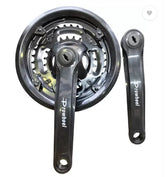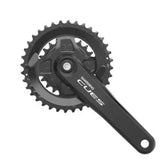The bicycle crankset is a key component in transferring the rider's pedal force to the bike’s drivetrain. It consists of several parts and is available in different materials, such as alloy and steel, with various designs depending on the type of bike and its intended use. Here's a detailed look at the crankset, its spare parts, and the differences between alloy and steel cranksets.
What is a Bicycle Crankset?
A crankset (also called the crank arm assembly) is made up of several parts and connects the pedals to the bottom bracket. It is responsible for converting the rider's pedaling power into motion, driving the bike’s chain and rear wheel.
Main Components of a Crankset:
-
Crank Arms: These are the levers that connect the pedals to the bike. They come in different lengths (typically measured in millimeters, e.g., 170mm, 175mm) to accommodate different rider sizes and cycling styles.
-
Chainrings: These are the toothed discs that the chain runs on. Cranksets usually have one, two, or three chainrings depending on the bike's gearing system (single, double, or triple).
-
Bottom Bracket: A component that holds the spindle that connects the crankset to the bike frame, allowing the crank arms to rotate smoothly.
-
Crank Bolts: These secure the crank arms to the spindle or bottom bracket.
Types of Cranksets
There are various crankset types, mainly determined by the number of chainrings and gear ratios:
-
Single Crankset (1x Crankset)
-
Description: Features a single chainring at the front, often found in modern mountain bikes, gravel bikes, and some road bikes for simplicity and weight reduction.
-
Best For: Riders who prioritize ease of use and efficiency, with less maintenance needed (no front derailleur).
-
Double Crankset (2x Crankset)
-
Description: Contains two chainrings, typically offering a wider range of gears. Common on road bikes and some hybrid bikes.
-
Best For: Road cyclists who want versatility, especially for hilly terrain, as it offers a larger gear range than a single chainring.
-
Triple Crankset (3x Crankset)
-
Description: Has three chainrings, providing a wide range of gearing. Used primarily on touring and mountain bikes for tackling steep, technical terrain.
-
Best For: Riders who need maximum gear range and versatility for challenging climbs or off-road conditions.
Material Choices for Cranksets: Alloy vs. Steel
1. Alloy Cranksets (Aluminum or Aluminum Alloys)
-
Material: Alloy cranksets are made from aluminum or aluminum alloys, which combine aluminum with other metals (such as magnesium or silicon) to improve strength, weight, and durability.
-
Advantages:
-
Lightweight: Alloy cranksets are much lighter than steel, which makes them ideal for road bikes, racing, and competitive cycling.
-
Corrosion-Resistant: Aluminum naturally resists rust, which makes alloy cranksets ideal for wet conditions.
-
Stiffness: Alloy cranksets are generally stiffer than steel ones, allowing for better power transfer from the rider to the drivetrain.
-
Affordable Options: Alloy cranksets are generally more affordable than high-end carbon cranksets, making them a great middle ground.
-
Disadvantages:
-
Durability: While alloys are strong, they can be more prone to damage from heavy impacts compared to steel cranksets.
-
Flexibility: Some alloy cranksets may flex under extreme loads or over time, though high-end alloy cranksets tend to have excellent rigidity.
-
Best For:
- Road cyclists looking for a lightweight and stiff crankset.
- Riders who want a corrosion-resistant option for moderate to high-performance cycling.
2. Steel Cranksets
Crankset Spare Parts
Whether you’re replacing a damaged crankset or upgrading to a higher-performance model, it's important to know about the various spare parts that you may need.
Common Crankset Spare Parts
-
Crank Arms
- If a crank arm is bent, damaged, or worn out, it can be replaced without replacing the entire crankset. Be sure to match the length and material of the replacement crank arm to your existing setup.
-
Chainrings
- The chainrings can wear out over time, especially with frequent shifting under load. Replace them if teeth are bent, worn down, or damaged.
- Chainrings come in different bolt patterns and sizes (e.g., 104 BCD, 110 BCD), so it’s important to match the bolt pattern to your crankset.
-
Crank Bolts
- Crank bolts secure the crank arms to the spindle. Over time, they can become loose, stripped, or rusted, requiring replacement. Use the correct size and material.
-
Bottom Bracket
- The bottom bracket holds the spindle and allows the crank arms to rotate. If your bottom bracket becomes worn or damaged (e.g., wobbling or creaking), it will need to be replaced.
- There are different types of bottom brackets (threaded, press-fit, etc.), so it's important to choose one that matches your frame.
-
Pedal Threads & Pedals
- Over time, pedal threads in the crank arms can wear out or get damaged. If you’re having difficulty installing or removing pedals, you may need to replace the crank arms.
-
Crankset Bolts & Washer Kits
- These small components can get stripped or lost, and they are necessary for securely attaching the crank arms to the bottom bracket.
Crankset Maintenance Tips
-
Regularly Check Crank Bolts: Crank bolts can loosen over time. Regularly inspect and tighten them to prevent issues with pedaling.
-
Lubricate Threads: Apply a small amount of grease to the threads of your bottom bracket and crank bolts to prevent seizing and rust.
-
Monitor Wear on Chainrings: Keep an eye on your chainrings for signs of wear, such as bent or broken teeth. If you notice skipping, it might be time to replace them.
-
Cleaning: Regularly clean your crankset and chainrings to prevent dirt buildup, which can cause premature wear.
Conclusion
-
Alloy Cranksets: Lightweight, stiff, and corrosion-resistant, these are ideal for road bikes, racing, and high-performance cycling.
-
Steel Cranksets: Strong, durable, and affordable, they are better for off-road cycling, touring, or bikes that require rugged, long-lasting components.
Both materials have their pros and cons, but choosing the right one depends on your riding style, performance needs, and budget. Regular maintenance and timely replacement of spare parts like chainrings and crank arms will ensure your crankset performs well for years.

















